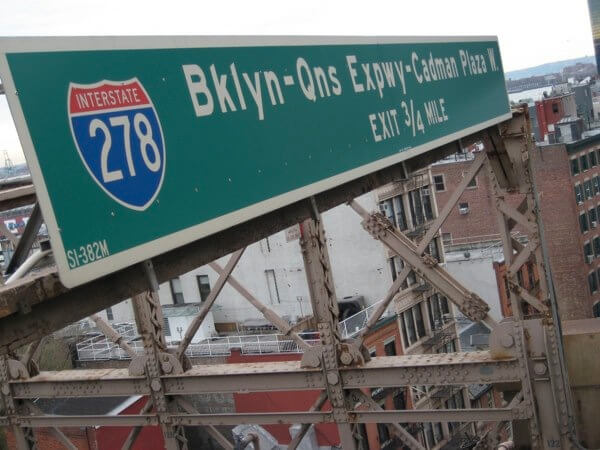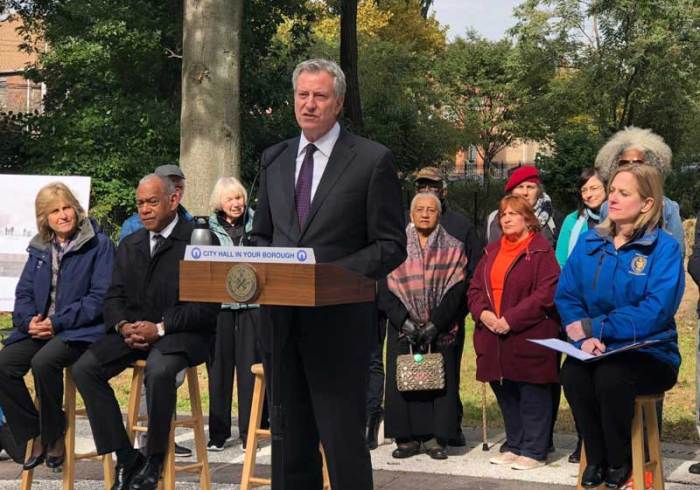On Wednesday, Aug. 4, the city unveiled a comprehensive preservation plan for the Brooklyn-Queens Expressway (BQE), which would extend the life of the BQE’s cantilever for “at least another 20 years” while also reconsidering the use of large diesel trucks on the corridor.
The four-part plan, presented by Mayor Bill de Blasio and Department of Transportation (DOT) Commissioner Hank Gutman, focused on preserving the structure; undertaking “immediate and ongoing” maintenance; monitoring the structure’s health and enforcing newly placed systems; and involving the community in the future of the BQE.
“We have the technology, the ideas and the expertise to save the BQE and we’re excited to execute this plan. But that’s just the start,” de Blasio said. “New York City can do more than patch up a highway in need of repair — we can use this opportunity to rethink how people, goods and services move around our city. I look forward to leading that process and finding fresh ways to use this resource to build a long-term recovery for all of us.”
The BQE opened to the public back in 1954, with Robert Moses responsible for much of the expressway’s plans and construction. Now nearly 70 years later, the DOT plan would provide “at least two more decades of life” from Sands Street to Atlantic Avenue in Brooklyn.
“This plan is designed to address current safety and structural concerns about the 70-year-old roadway, while reimagining not only its future purpose but how freight is moved in this city in the 21st century,” Gutman said.
DOT proposed several ways to preserve the BQE for at least 20 years: stopping water infiltration, shifting lane markings and monitoring and managing traffic.
Stopping water infiltration
According to the agency, stopping water from coming into the corridor would slow down the corrosion of the structures that is currently happening. In order to mitigate water intrusion, DOT would address the expressway’s joints, improve the drainage system and reintroduce waterproofing, all while maintaining these newly implemented features.
Shifting lane markings
Back in 2019, an expert panel put together to “comprehensively evaluate the BQE project,” proposed that DOT shift the expressway’s lane markings along a half-mile segment — approximately from Atlantic Ave to the Brooklyn Bridge — from three lanes in each direction to two lanes.
The current pavement markings on the BQE include three “sub-standard width” lanes, which measure in at about 10.5 feet instead of 12 feet as is typical on most highways. Under the plan, those lanes would be replaced with two wider lanes and a shoulder, allowing for improved entry lanes at Atlantic Avenue.
According to the city, the changes would reduce weight along a critical segment of the structure, improve roadway safety and reduce delays caused by breakdowns and collisions.
Monitoring and managing traffic
DOT said that it would come up with a “comprehensive traffic management and monitoring plan” on top of a plan to protect neighborhoods in order to minimize motorist and resident disruption.
Overweight trucks will be detected by new “weigh-in-motion” technology and drivers of the vehicles will be fined. In recent months, NYPD increased weight enforcement on the BQE, with a fivefold increase in summonses since February.
Once a month, NYPD will employ extra units to increase these efforts.
Immediate and ongoing maintenance
The agency said that it would complete ongoing concrete and rebar repairs on the Hicks Street retaining wall this year. Next year, it will begin work on two deck spans showing faster signs of deterioration.
Sensors that the city installed along the BQE will help monitor the structure’s health by providing a real-time picture of how traffic affects it.
Preliminary results will available later this summer and full results by next spring.
Developing a long-term vision
To involve affected groups concerning the BQE’s long-term future, the city will engage communities from Queens to Staten Island including businesses and the freight industry.
The city’s truck management plan will incentivize off-hour deliveries, freight consolidation, cargo bike deliveries in an attempt to manage freight deliveries during the most congested times of day. The plan also said that the city would promote and incentivize the use of safer, cleaner vehicles and technology via the expansion of the NYC Clean Truck Program.
The goal would be to make significant shifts from trucks to movement by water or rail — eliminating up to 20 million truck miles annually — diminishing congestion and improving air quality.
Laura Anglin, deputy mayor for Operations, said repairing and restoring the BQE takes “creativity, ingenuity and hard work.”
“I’m proud to lay out a plan that relies on just that,” Anglin said.“This plan will preserve an essential part of our city’s infrastructure for years to come, and I look forward to thinking creatively about its future.”
Rachel Loeb, president and CEO of the New York City Economic Development Corporation, said to drive economic development, they must invest in sustainable roadways and decrease reliance on diesel trucks to transport goods.
“Tens of thousands of New Yorkers depend on the BQE, and aging infrastructure and truck congestion have been long-standing problems. NYCDOT’s plan will work to address needed maintenance and repairs to make the expressway safer and will allow commerce to move more efficiently, helping our city’s businesses and residents,” Loeb said. “NYCEDC will continue to support the city in its long-term vision to also ease truck congestion with water and rail solutions, which will reduce traffic and harmful emissions.”
According to the Coalition for the BQE Transformation, which has been advocating for a comprehensive plan for the corridor, the announcement is an important step in the right direction.
Across the nation, as the destructive effects of urban highways are being recognized and addressed, the coalition said the transformation of the BQE, one of NYC’s most decrepit and polluting transportation corridors, is of critical importance to the future of the city.
“The Coalition for the BQE Transformation (BQET) applauds the immediate measures which DOT is taking to ensure the safety of the Triple Cantilever because this plan buys New Yorkers time to develop a truly visionary solution to what has been a political hot potato for more than 20 years,” the coalition stated.
The coalition added that the planning to “reverse the negative environmental, economic and public health impacts of the BQE must begin now.”
“We will hold the city to its commitment to move forward immediately with structured and substantive engagement with all the communities along the BQE corridor,” they stated.
Additional reporting by Jenna Bagcal.


































